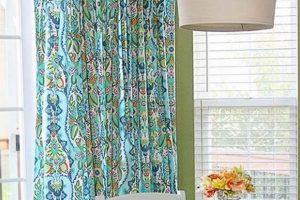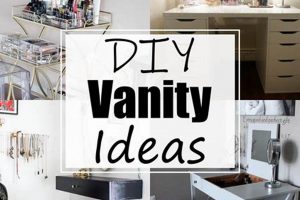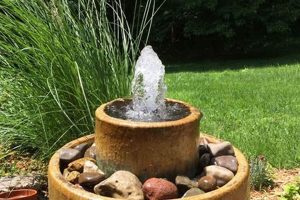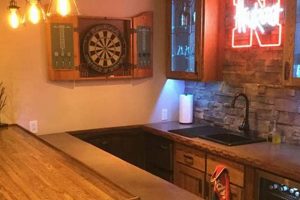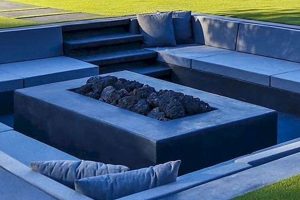The concept involves constructing a water feature for avian creatures utilizing materials readily available or repurposed. Examples range from simple terracotta saucer and pot combinations to more elaborate designs incorporating upcycled tires or repurposed sinks. These projects offer an opportunity to provide a beneficial resource for birds while engaging in creative, hands-on activities.
Providing a consistent water source is crucial for bird hygiene and hydration, particularly during warmer months or periods of drought. Historically, individuals have created rudimentary water features to attract birds to their gardens, fostering a closer connection with nature and contributing to local biodiversity. The practice offers both aesthetic and ecological advantages, enhancing outdoor spaces and supporting wildlife.
Subsequent sections will explore various approaches to crafting these avian watering holes, detailing material selection, construction techniques, and considerations for safety and maintenance. These DIY projects cater to a range of skill levels and budgets, empowering individuals to create welcoming habitats for feathered friends.
Crafting Sustainable Avian Watering Holes
The following guidelines offer practical advice for constructing safe and effective water features for birds, ensuring both functionality and longevity. Adhering to these recommendations will maximize the benefits for avian visitors while minimizing potential hazards.
Tip 1: Select Durable and Non-Toxic Materials: When constructing a watering hole for birds, the selection of materials is paramount. Opt for substances such as terracotta, stone, or sealed concrete, which are resistant to weathering and will not leach harmful chemicals into the water. Avoid using treated wood or plastics that may degrade over time and contaminate the water source.
Tip 2: Ensure a Gradual Slope: A critical aspect of avian safety is providing varying water depths. Incorporate a gentle incline within the basin, allowing birds of different sizes and abilities to access the water comfortably. Shallow edges are especially important for smaller birds and fledglings, preventing accidental drowning.
Tip 3: Prioritize Ease of Cleaning: Regular maintenance is essential for preventing the buildup of algae and bacteria, which can be detrimental to bird health. Design the watering hole with smooth, non-porous surfaces that are easily scrubbed and disinfected. A removable basin or a design that facilitates drainage will simplify the cleaning process.
Tip 4: Position Strategically for Safety: The location of the water feature significantly impacts its utility and safety. Position it in an open area away from dense vegetation where predators, such as cats, can easily ambush birds. A clear line of sight provides birds with ample warning of potential threats.
Tip 5: Provide a Stable Base: A secure foundation is necessary to prevent the watering hole from tipping or collapsing. Ensure the base is level and stable, especially if the structure is tall or heavy. Consider anchoring the base to the ground or using a wide, solid platform for added stability.
Tip 6: Incorporate Textural Elements: Adding natural elements, such as pebbles or small stones, to the basin floor provides birds with secure footing and encourages them to use the water feature. These elements also create a more natural and inviting environment.
Tip 7: Consider Water Circulation: Introducing gentle water movement, such as a small solar-powered fountain or dripper, can help to discourage mosquito breeding and maintain water freshness. However, ensure the water flow is not too strong, as this may deter birds from using the watering hole.
By adhering to these considerations, individuals can create attractive and beneficial water features for birds, promoting their well-being and enhancing the ecological value of outdoor spaces. A well-designed and maintained watering hole provides a valuable resource for birds, contributing to local biodiversity and fostering a connection with nature.
The subsequent section will delve into specific design ideas, offering inspiration for crafting unique and functional watering holes for avian visitors.
1. Material Suitability
Material suitability represents a cornerstone in the successful execution of water features intended for avian use. The selection of appropriate materials directly impacts the structure’s longevity, safety, and overall utility for birds. Careful consideration must be given to factors such as toxicity, durability, and weather resistance to ensure a beneficial and sustainable outcome.
- Non-Toxicity and Water Quality
Materials employed must be demonstrably non-toxic to avoid contaminating the water supply and posing a health risk to birds. Certain metals, treated woods, and plastics can leach harmful chemicals into the water, rendering it unsuitable for consumption and bathing. Acceptable alternatives include terracotta, unglazed ceramic, natural stone, and sealed concrete. The selection should prioritize preserving water purity.
- Durability and Weather Resistance
Avian watering holes are exposed to a range of environmental conditions, including sunlight, rain, and temperature fluctuations. Therefore, materials must exhibit robust durability and weather resistance to withstand these elements without degrading or compromising structural integrity. Materials prone to cracking, chipping, or rapid deterioration are unsuitable. Frost resistance is especially critical in climates with freezing temperatures.
- Surface Texture and Grip
The surface texture of the material influences a bird’s ability to safely access and utilize the water feature. Smooth, slippery surfaces can pose a hazard, leading to accidental falls or difficulty in maintaining a secure grip. Selecting materials with a slightly rough or textured surface provides birds with better traction and stability. The inclusion of pebbles or small stones within the basin can further enhance grip and create a more natural environment.
- Cleanability and Maintenance
The ease with which a material can be cleaned and maintained directly impacts the long-term hygiene and usability of the water feature. Porous materials, such as untreated wood, can harbor bacteria and algae, requiring more frequent and intensive cleaning. Non-porous materials like glazed ceramic and sealed concrete are easier to disinfect and maintain, reducing the risk of disease transmission among avian visitors.
The interplay between material selection and these critical factors dictates the overall success of the avian water feature. Prioritizing non-toxicity, durability, appropriate surface texture, and ease of maintenance is paramount in creating a safe, functional, and sustainable resource for birds, contributing positively to their well-being and enhancing the ecological value of outdoor spaces.
2. Structural Stability
Structural stability, in the context of DIY avian watering holes, denotes the capacity of the constructed apparatus to withstand applied forces and environmental stressors without experiencing catastrophic failure or significant deformation. This characteristic is crucial for ensuring the safety of avian visitors and prolonging the service life of the structure.
- Base Integrity and Load Distribution
The base of the avian watering hole must possess sufficient load-bearing capacity to support the combined weight of the structure itself and the contained water volume. Inadequate base design may result in tilting, cracking, or complete collapse. Load distribution principles dictate that weight should be evenly dispersed across the base to minimize stress concentrations. For instance, a wide, stable base made of reinforced concrete or a sturdy metal frame provides superior support compared to a narrow, unstable platform. The implications of base failure extend beyond structural damage, potentially endangering birds using the water source.
- Material Strength and Joint Integrity
The constituent materials of the avian watering hole must exhibit adequate tensile and compressive strength to resist deformation and fracture under load. Material selection should account for anticipated stress levels and environmental conditions. Additionally, the joints connecting different structural elements must be robust and properly executed to prevent separation or weakening. Welded joints, bolted connections with locking mechanisms, or the use of high-strength adhesives are recommended for ensuring joint integrity. A failure in material strength or joint integrity can lead to localized structural weakness, increasing the risk of collapse.
- Wind Resistance and Uplift Prevention
Avian watering holes, particularly those with large surface areas or elevated designs, are susceptible to wind forces that can induce overturning moments or uplift. Designing for wind resistance involves minimizing the structure’s profile, employing aerodynamic shapes, and incorporating anchorage mechanisms to secure the structure to the ground. Wide bases, ballast weights, or ground anchors can effectively counteract wind-induced uplift. Failure to address wind resistance can result in the structure being blown over, causing damage and potentially harming birds.
- Resistance to Environmental Degradation
The materials used in the DIY bird bath are constantly exposed to the elements, which can cause the structure to degrade over time. Moisture, temperature fluctuations, and UV radiation can weaken materials, leading to cracks, rust, or rot. Choosing weather-resistant materials and applying protective coatings can help prolong the lifespan of the bird bath. Regularly inspecting the structure for signs of damage and making necessary repairs can also prevent further degradation.
The integration of these structural considerations into the design and construction phases of avian watering holes is paramount for ensuring their safety, durability, and long-term functionality. A structurally sound watering hole provides a reliable water source for birds, contributing to their well-being and enhancing the ecological value of outdoor spaces. The absence of adequate structural integrity can compromise the integrity of the construction.
3. Avian Accessibility
Avian accessibility constitutes a critical design parameter in the effective implementation of water features intended for avian species. It encompasses the physical characteristics and spatial arrangements that facilitate safe and convenient access to water for drinking and bathing. Neglecting avian accessibility considerations can render a watering hole ineffective or even hazardous to birds.
- Slope Gradient and Water Depth
The slope gradient of the basin and the resulting water depth are primary determinants of avian accessibility. Abrupt transitions from dry land to deep water can deter or even endanger smaller birds. A gradual incline allows birds of varying sizes and swimming abilities to access the water comfortably and safely. Ideally, the basin should incorporate shallow areas with a water depth of no more than 1-2 inches to accommodate smaller species and fledglings.
- Perch Availability and Placement
Perches provide birds with a stable platform to approach the water, preen themselves, and observe their surroundings. The presence of perches can significantly increase the attractiveness and usability of a watering hole. Perches should be strategically placed around the perimeter of the basin, providing multiple access points and vantage points. Natural materials such as small branches or stones are preferable to artificial perches.
- Surface Texture and Grip
The surface texture of the basin floor and surrounding area influences a bird’s ability to maintain a secure grip, especially when wet. Smooth, slippery surfaces can lead to accidental falls or difficulty in accessing the water. A textured surface, achieved through the use of materials such as rough stone or the addition of pebbles, provides birds with better traction and stability. This aspect is particularly crucial in areas where birds enter and exit the water.
- Spatial Clearance and Approach Paths
The surrounding environment should provide ample spatial clearance for birds to approach and depart from the watering hole without obstruction. Dense vegetation or proximity to structures can create obstacles and increase the risk of collisions. Clear approach paths and open areas around the water feature allow birds to maneuver safely and confidently.
These facets of avian accessibility directly influence the utilization and safety of self-constructed avian watering holes. A thoughtfully designed and implemented DIY water feature, incorporating gradual slopes, strategically placed perches, textured surfaces, and clear approach paths, maximizes its attractiveness and utility to a diverse range of avian species. Conversely, neglecting these considerations can render the structure ineffective or even dangerous, negating the intended benefits.
4. Maintenance Simplicity
The ease with which a constructed avian watering hole can be maintained directly influences its long-term viability and benefit to avian populations. Maintenance simplicity, therefore, represents a crucial consideration in the conception and execution of DIY bird bath projects, impacting both the health of visiting birds and the sustained usability of the feature itself.
- Material Selection and Cleanability
Material choice significantly dictates the effort required for routine cleaning. Non-porous materials such as glazed ceramic, sealed concrete, or durable plastics resist the absorption of organic matter and algal growth, facilitating easier removal of contaminants. Conversely, porous materials such as untreated wood or unsealed terracotta require more rigorous cleaning protocols and are more susceptible to harboring harmful bacteria. The selection of readily cleanable materials thus directly translates to reduced maintenance dem
ands. - Design for Accessibility
The physical design of the bird bath should prioritize accessibility for cleaning purposes. Designs incorporating intricate crevices, deep recesses, or non-removable components impede thorough cleaning, increasing the risk of bacterial and algal proliferation. Simple, open designs with smooth surfaces and removable basins or components facilitate easier access for scrubbing and disinfection, promoting hygienic conditions for avian visitors.
- Drainage Facilitation
Effective drainage mechanisms are essential for preventing the accumulation of stagnant water and organic debris, which can foster the growth of harmful microorganisms. Bird baths incorporating drainage holes or sloped bases allow for the complete emptying of the basin, simplifying the removal of sediment and facilitating rinsing. Designs lacking adequate drainage are more prone to algal blooms and require more frequent and labor-intensive cleaning.
- Regular Cleaning Schedule Implementation
Even with the most carefully selected materials and accessible design, a consistent cleaning schedule is necessary to maintain optimal hygiene. Depending on environmental factors such as sunlight exposure, temperature, and the prevalence of avian activity, routine cleaning should be conducted at least once or twice per week. Neglecting to adhere to a regular cleaning schedule can negate the benefits of a well-designed bird bath, leading to the accumulation of harmful pathogens and a decline in avian usage.
In conclusion, maintenance simplicity is inextricably linked to the long-term success of DIY bird bath projects. By prioritizing readily cleanable materials, accessible designs, effective drainage mechanisms, and consistent cleaning schedules, constructors can ensure that their creations remain safe, hygienic, and attractive to avian visitors for years to come. Conversely, neglecting these considerations can result in a decline in avian usage, increased risk of disease transmission, and the premature abandonment of the project.
5. Location Safety
Location safety forms an indispensable element within the conceptual framework of DIY bird bath projects. The selected location exerts a profound influence on avian visitation rates, susceptibility to predation, and the overall ecological impact of the implemented water feature. A poorly chosen location can negate the intended benefits of the project, potentially placing birds at increased risk.
Placement near dense shrubbery, for instance, presents an elevated predation risk. While providing cover, it simultaneously offers ambush points for felines and other predators. Conversely, positioning the bird bath in an expansive, exposed area devoid of nearby perches may deter birds, lacking a secure transition point. Proximity to human activity, such as frequently used walkways or noisy machinery, can also dissuade avian usage. A more suitable location entails a balance: sufficient visibility to deter predators coupled with accessible perches and a degree of shelter. An example would be placing it within a few feet of a small tree or sturdy shrub, allowing birds an easy escape route. Furthermore, consideration must be given to potential hazards such as power lines or reflective windows, which can lead to avian collisions.
Optimal location safety also extends to practical considerations. The ground should be level and stable to prevent tipping. The area should be readily accessible for cleaning and maintenance, reducing the likelihood of neglect. It’s also beneficial to situate the bird bath near a water source, simplifying the refilling process. Failing to address location safety issues can undermine even the most meticulously designed and constructed bird bath. Thoughtful consideration of these factors contributes significantly to the overall success and ecological value of the project. It helps ensure it serves as a valuable resource for avian fauna.
Frequently Asked Questions
The following addresses common inquiries regarding the design, construction, and maintenance of DIY avian watering holes. This information aims to provide clarity and guidance for individuals seeking to create safe and beneficial water sources for birds.
Question 1: What constitutes an appropriate material for avian watering hole construction?
Suitable materials include terracotta, unglazed ceramic, natural stone, and sealed concrete. These substances are non-toxic, durable, and resistant to weathering. Avoid treated wood or plastics that may leach harmful chemicals into the water.
Question 2: How can algal growth be minimized in an avian watering hole?
Regular cleaning, at least once or twice per week, is essential. Scrub the basin with a brush and a diluted bleach solution (one part bleach to nine parts water), followed by thorough rinsing. Locating the bird bath in a partially shaded area can also help reduce algal growth.
Question 3: What water depth is most suitable for avian bathing and drinking?
A shallow water depth, not exceeding 1-2 inches, is ideal. Incorporating a gradual slope within the basin allows birds of varying sizes to access the water safely. Shallower depths are particularly important for smaller species and fledglings.
Question 4: How can predation risks be mitigated at avian watering holes?
Position the bird bath in an open area away from dense vegetation where predators can easily ambush birds. Maintain a clear line of sight around the water feature. Consider adding thorny shrubs nearby to provide a safe haven for birds to retreat to if threatened.
Question 5: What are the implications of using chemically treated water in an avian watering hole?
Chemically treated water, such as softened or chlorinated water, can be harmful to birds. Use fresh, clean water from a well, rainwater collection system, or dechlorinated tap water. If using tap water, allow it to sit for 24 hours to allow chlorine to dissipate.
Question 6: How frequently should the water in an avian watering hole be changed?
The water should be changed daily, or at least every other day, to prevent the buildup of bacteria and algae. Regular water changes also remove debris such as leaves, feathers, and insect larvae. More frequent changes may be necessary during periods of high temperatures or heavy usage.
Proper design, construction, and diligent maintenance practices are essential for ensuring that DIY avian watering holes function as beneficial and safe resources for local bird populations. Adherence to these guidelines contributes to the well-being of avian fauna and enhances the ecological value of outdoor spaces.
Subsequent sections will explore advanced design concepts for avian watering holes, incorporating features such as integrated planting and sustainable water management techniques.
Conclusion
The foregoing exploration of “bird bath diy ideas” has underscored the multifaceted considerations inherent in creating effective and safe avian watering holes. Key points included material selection, structural integrity, avian accessibility, maintenance simplicity, and location safety. A comprehensive understanding of these elements is crucial for successful implementation.
The construction of avian watering holes represents a tangible means of supporting local biodiversity. These projects provide essential resources for birds while fostering a connection with the natural world. Continued inn
ovation in design and construction techniques promises to further enhance the ecological value and sustainability of avian watering initiatives.


